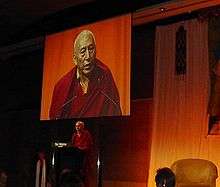Lobsang Tenzin
| Lobsang Tenzin | |
|---|---|
|
| |
| Prime Minister of the Central Tibetan Administration | |
|
In office 5 September 2001 – 8 August 2011 | |
| Monarch | Tenzin Gyatso |
| Preceded by | Sonam Topgyal |
| Succeeded by | Lobsang Sangay |
| Personal details | |
| Born |
5 November 1939 Jol, Tibet |
| Alma mater | Drepung Monastery |
| Religion | Vajrayana Buddhism |
Lobsang Tenzin, better known by the titles Professor Venerable Samdhong Rinpoche (zam gdong rin po che) and to Tibetans as the 5th Samdhong Rinpoche (born 5 November 1939), was the previous prime minister (officially Kalon Tripa, or chairman of the cabinet), of the Central Tibetan Administration, or Tibetan government-in-exile, which is based in Dharamshala, India; Lobsang Sangay was elected to this position in April 2011.
A close associate of 14th Dalai Lama, the Tibetan leader, he was elected to his current position in 2001.
Lobsang Tenzin was born in Jol, in eastern Tibet. At the age of five, he was recognised, according to Tibetan tradition, as the reincarnation of the 4th Samdhong Rinpoche and enthroned in Gaden Dechenling Monastery at Jol. Two years later he took vows as a monk, started his religious training at Drepung Monastery in Lhasa and completed it at the Madhyamika School of Buddhism. But in 1950, after the Chinese invasion of Tibet, he was forced to go into exile in India along with the 14th Dalai Lama, Tenzin Gyatso.
From 1960 onwards Lobsang Tenzin worked as a teacher in Tibetan religious schools in India, first in Simla and later in Darjeeling. Between 1965 and 1970 he was the Principal of Dalhousie Tibetan School and between 1971 and 1988 he was the Principal of Central Institute of Higher Tibetan Studies (CIHTS) at Varanasi (Benares), and from 1988 to 2001 he was the director. He is regarded as one of the leading Tibetan scholars of Buddhism and is also an authority on the teachings of Mahatma Gandhi. He is fluent in Hindi and English, Tibetan being his mother tongue.
In 1991 Lobsang Tenzin was appointed by the Dalai Lama as a member of the Assembly of Tibetan People's Deputies, and later was unanimously elected as its chairman. Between 1996 and 2001 he was an elected member of the Assembly representing exiled Tibetans from Kham province and also its chairman.
In 2000 the Dalai Lama decided that the Tibetan people in exile should elect their own Prime Minister, and in July 2001 Lobsang Tenzin was elected with about 29,000 votes, or about 84% of those cast, which is about 25% of the exile Tibetan population. Juchen Thubten Namgyal, the other candidate, won the remainder.[1] Since 2001 he has travelled extensively to gain support for the cause of Tibetan autonomy and raise awareness of the Dalai Lama's proposals for negotiating autonomy with the Chinese government.
Note on his name
Lobsang Tenzin is his given Tibetan name. His legal name in India is Samdhong Rinpoche, although in fact this is a Tibetan religious title, like the Dalai Lama. In English he is commonly called Professor Rinpoche, and accepts this although it is incorrect. Tibetans address him as Rinpoche, which literally means "the precious one", used to be styled tulkus (incarnate lamas).
References
Citations
Sources
- Samdhong Rinpoche: Uncompromising Truth for a Compromised World (World Wisdom, 2006) ISBN 978-1-933316-20-8
External links
| Wikimedia Commons has media related to Samdhong Rinpoche. |
- Interview of Prof Samdhong Rinpoche - The Tibetan Prime Minister in Exile with Saransh Sehgal
- News of his election
- Central Tibetan Administration
- / Chancellor Sanchi Buddhist-Indic Studies University Sam Dong Rimpoche http://www.sanchiuniv.org.in
- Australia-Tibet Council: Interview with Samdhong Rinpoche
- Author Page
| Political offices | ||
|---|---|---|
| Preceded by Sonam Topgyal |
Prime Minister of the Central Tibetan Administration 2001–2011 |
Succeeded by Lobsang Sangay |
